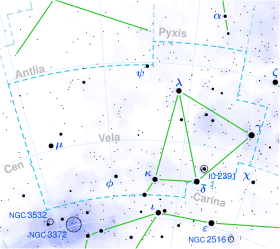| Observation data Epoch J2000.0 Equinox J2000.0 | |
|---|---|
| Constellation | Vela |
| Right ascension | 08h 40m 17.58553s[1] |
| Declination | −52° 55′ 18.8002″[1] |
| Apparent magnitude (V) | +3.60[2] (3.57 – 3.63[3]) |
| Characteristics | |
| Spectral type | B3/5(V)[4] |
| U−B color index | −0.62[2] |
| B−V color index | −0.18[2] |
| Variable type | SPB[3] |
| Astrometry | |
| Radial velocity (Rv) | +16.1±0.7[5] km/s |
| Proper motion (μ) | RA: −24.42[1] mas/yr Dec.: +34.44[1] mas/yr |
| Parallax (π) | 6.61 ± 0.35 mas[1] |
| Distance | 490 ± 30 ly (151 ± 8 pc) |
| Absolute magnitude (MV) | −2.48[6] |
| Details | |
| Mass | 5.5±0.4[7] M☉ |
| Radius | 4.3±0.7[7] R☉ |
| Luminosity | 1,000[7] L☉ |
| Surface gravity (log g) | 3.91±0.20[7] cgs |
| Temperature | 16,200±700[7] K |
| Rotational velocity (v sin i) | 9±5[7] km/s |
| Age | 39.8[8] Myr |
| Other designations | |
| Database references | |
| SIMBAD | data |
Omicron Velorum (ο Vel, ο Velorum) is a star in the constellation Vela. It is the brightest member of the loose naked eye open cluster IC 2391, also known as the ο Velorum Cluster.

Omicron Velorum is a blue-white B-type star with a mean apparent magnitude of +3.60. It is probably a main sequence object,[4][10] but has also been classified as a subgiant or giant.[11] It is approximately 495 light years from Earth. A slowly pulsating B star, it ranges between magnitudes 3.57 and 3.63 over 2.8 days.[3]
The correct Bayer designation for ο Velorum has been debated. Lacaille assigned one Greek letter sequence for the bright stars of Argo Navis. These Lacaille designations are now shared across the three modern constellations of Carina, Puppis, and Vela so that (except for omicron) each Greek letter is found in only one of the three.[12][13] However, ο (omicron) is now commonly used for two stars, one each in Vela and Puppis. In the Coelum Australe Stelliferum itself, ο Velorum is labelled ο (omicron) Argus (du Navire in the French edition), while ο Puppis is labelled (Latin) o Argus in puppi (Pouppe du Navire in the French edition).[14][15][16] Some later authors state the reverse, that Lacaille actually assigned omicron to ο Puppis and Latin lower case 'o' to ο Velorum.[17]. Modern catalogs and atlases generally use omicron for both stars.
- ^ a b c d e Cite error: The named reference
aaa474_2_653was invoked but never defined (see the help page). - ^ a b c Cite error: The named reference
clpl4was invoked but never defined (see the help page). - ^ a b c Cite error: The named reference
gcvswas invoked but never defined (see the help page). - ^ a b Cite error: The named reference
houk1978was invoked but never defined (see the help page). - ^ Cite error: The named reference
Gontcharov2006was invoked but never defined (see the help page). - ^ Cite error: The named reference
Anderson2012was invoked but never defined (see the help page). - ^ a b c d e f Cite error: The named reference
an330_4_317was invoked but never defined (see the help page). - ^ Cite error: The named reference
tetzlaff2011was invoked but never defined (see the help page). - ^ Cite error: The named reference
MASTwas invoked but never defined (see the help page). - ^ Cite error: The named reference
dr3was invoked but never defined (see the help page). - ^ Cite error: The named reference
skiff2014was invoked but never defined (see the help page). - ^ Cite error: The named reference
lacaillewas invoked but never defined (see the help page). - ^ Cite error: The named reference
xrefwas invoked but never defined (see the help page). - ^ Cite error: The named reference
latinwas invoked but never defined (see the help page). - ^ Cite error: The named reference
frenchwas invoked but never defined (see the help page). - ^ Cite error: The named reference
wagmanwas invoked but never defined (see the help page). - ^ Cite error: The named reference
hrwas invoked but never defined (see the help page).
